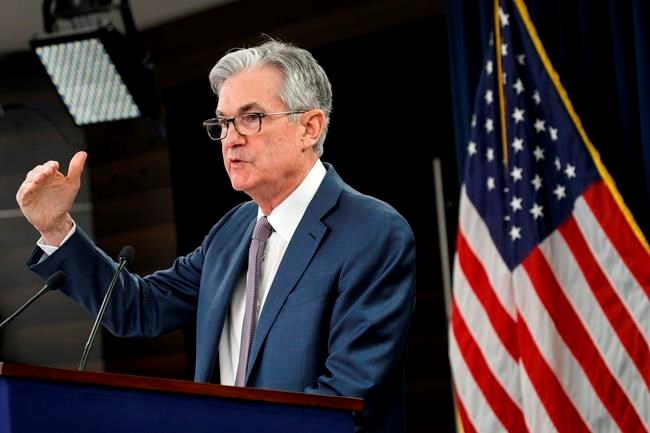WASHINGTON — The Federal Reserve announced a significant change Thursday in how it manages interest rates by saying it plans to keep rates near zero even after inflation has exceeded its 2% target level.
The change means the Fed is prepared to tolerate a higher level of inflation than it generally has in the past. And it means that borrowing rates for households and businesses — for everything from auto loans and home mortgages to corporate expansion — will likely remain ultra-low for years to come.
The new goal states that “following periods when inflation has been running persistently below 2%, appropriate monetary policy will likely aim to achieve inflation moderately above 2% for some time.”
Behind the Fed’s new thinking is an ailing economy in the grip of a viral pandemic and a stubbornly low inflation rate that has long defied the Fed’s efforts to raise it. The policy change underscores the Fed's belief that an exceedingly low jobless rate is critically important for the economy and for individual Americans and that it should focus its efforts on achieving it.
In a speech detailing the changes, Chairman Jerome Powell made clear that the policy change reflects the reality that high inflation — once the biggest threat to the economy — no longer appears to pose a serious danger, even when unemployment is low and the economy is growing strongly. Rather, Powell said, the economy has changed in a way that allows the Fed to keep rates much lower than it otherwise would without igniting price pressures.
“The economy is always evolving,” Powell said. “Our revised statement reflects our appreciation for the benefits of a strong
Powell suggested that the Fed's decision before the pandemic hit to keep rates low had helped to finally improve the fortunes of low-income workers, who had previously shared in few of the benefits of a record-long economic expansion.
“The robust job market," he said, "was delivering life-changing gains for many individuals, families and communities, particularly at the lower end of the income spectrum.”
The chairman's comments came at the Fed’s annual gathering of global central bankers and top economists, normally held in Jackson Hole, Wyoming, against a backdrop of the towering Grand Teton Mountains but this time conducted virtually because of the pandemic.
The Fed's goal in revamping its policy stance on inflation is to drive home to borrowers and investors that its benchmark rate, which influences many consumer and business loans, will likely stay ultra-low for years to come. What’s new is the message that the Fed is prepared to accept a level of inflation that in the past it would not have tolerated while keeping rates near record lows.
The renewed emphasis on low rates to support the economy comes at a perilous time. Unemployment is still in double digits, and roughly 1 million people are applying for jobless aid each week even as the amount of aid they receive has shrunk. Consumer confidence has tumbled.
In a question-and-answer session after his speech, Powell struck a cautionary note about the economy and suggested, as he has before, that its recovery will depend heavily on when the health crisis can be solved.
“If we can keep the disease under control, the economy can improve fairly quickly,” he said.
But he noted that sectors of the economy that have been hardest hit, notably travel and tourism, will take longer to recover.
In its policy announcement Thursday, the Fed said the changes to its 2012 framework had been approved unanimously by its interest-setting panel. Powell said the policy will be reviewed annually. Economists said that while the policy changes had been expected, they amounted to a far-reaching shift.
“The formal adoption (of the new policy framework), along with Powell's still cautious economic outlook, underscore that the Fed will keep rates near zero for a long time,” said Kathy Bostjancic, chief U.S. financial economist at Oxford Economics.
She said she continued to believe the Fed would not begin raising rates until 2024.
Though the stock market and home sales are surging, the economy is struggling to grow, and millions face potential evictions from their homes. Congress is deadlocked over how much more aid to supply on top of the $3 trillion in support it has already approved since the pandemic shut down the economy in March. If the impasse cannot be resolved, many economists fear the country could tumble into an even deeper recession.
The chairman’s speech to an annual gathering of central bank officials is normally a hot ticket in the economic world, with coveted invitations going to a select few. This year, the event is being live-streamed to all on the YouTube site of the Federal Reserve Bank of Kansas City, which sponsors it.
The Fed announced the start of its reassessment of its interest-rate policy in November 2018, a process that included town-hall meetings with ordinary Americans around the country so that the policymakers could hear first-hand about the impact of their policies.
The minutes of its most recent policy meeting in late July had prompted speculation that the Fed would formally announce the changes at its next meeting in mid-September. Instead, the FOMC panel unveiled the changes Thursday, and Powell used his speech to explain them.
Right now, the Fed’s preferred inflation gauge is hovering at a sub-1% annual rate, well below its 2% target. Since the 2% target was officially adopted in 2012, the Fed has never consistently hit that level.
Martin Crutsinger, The Associated Press



